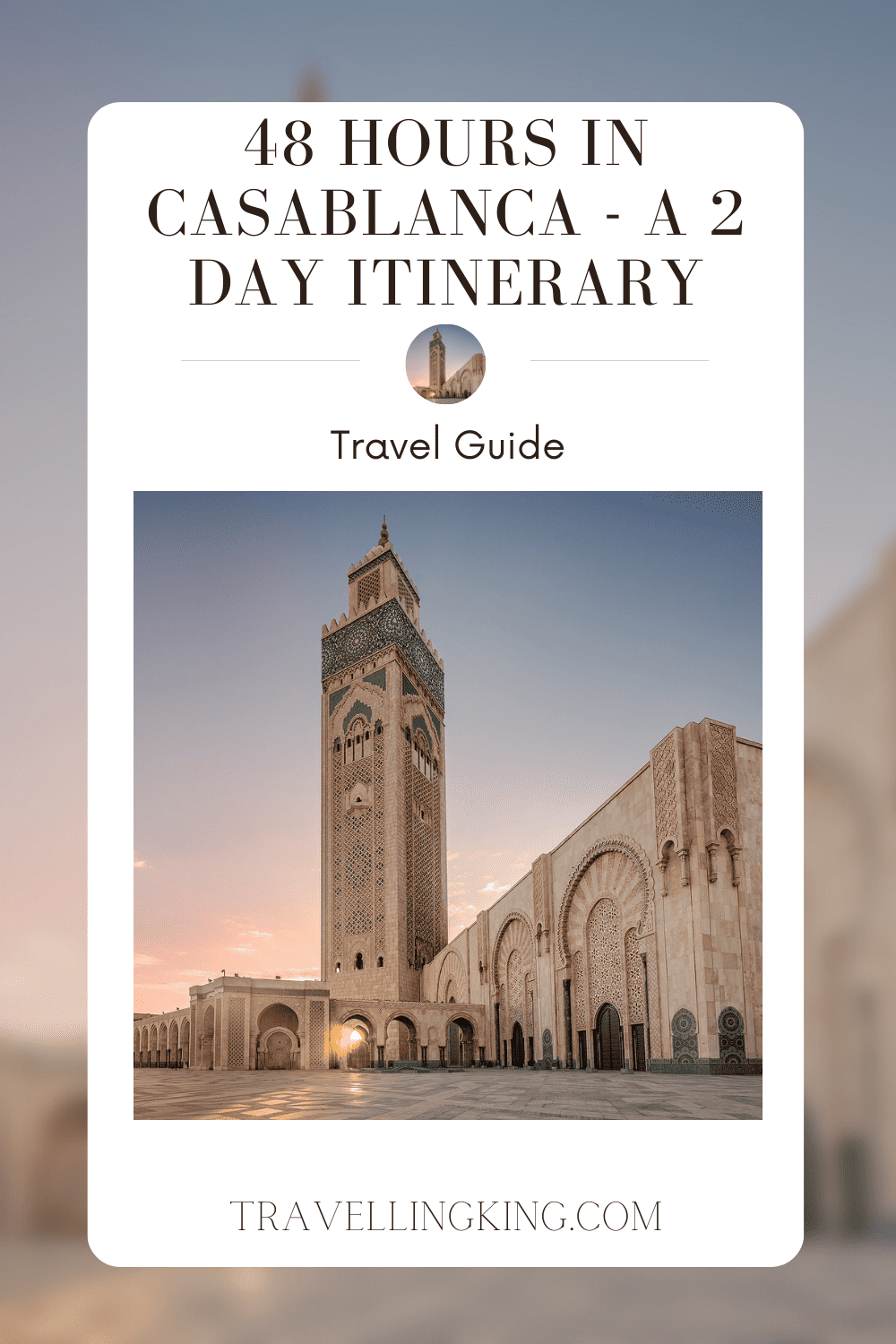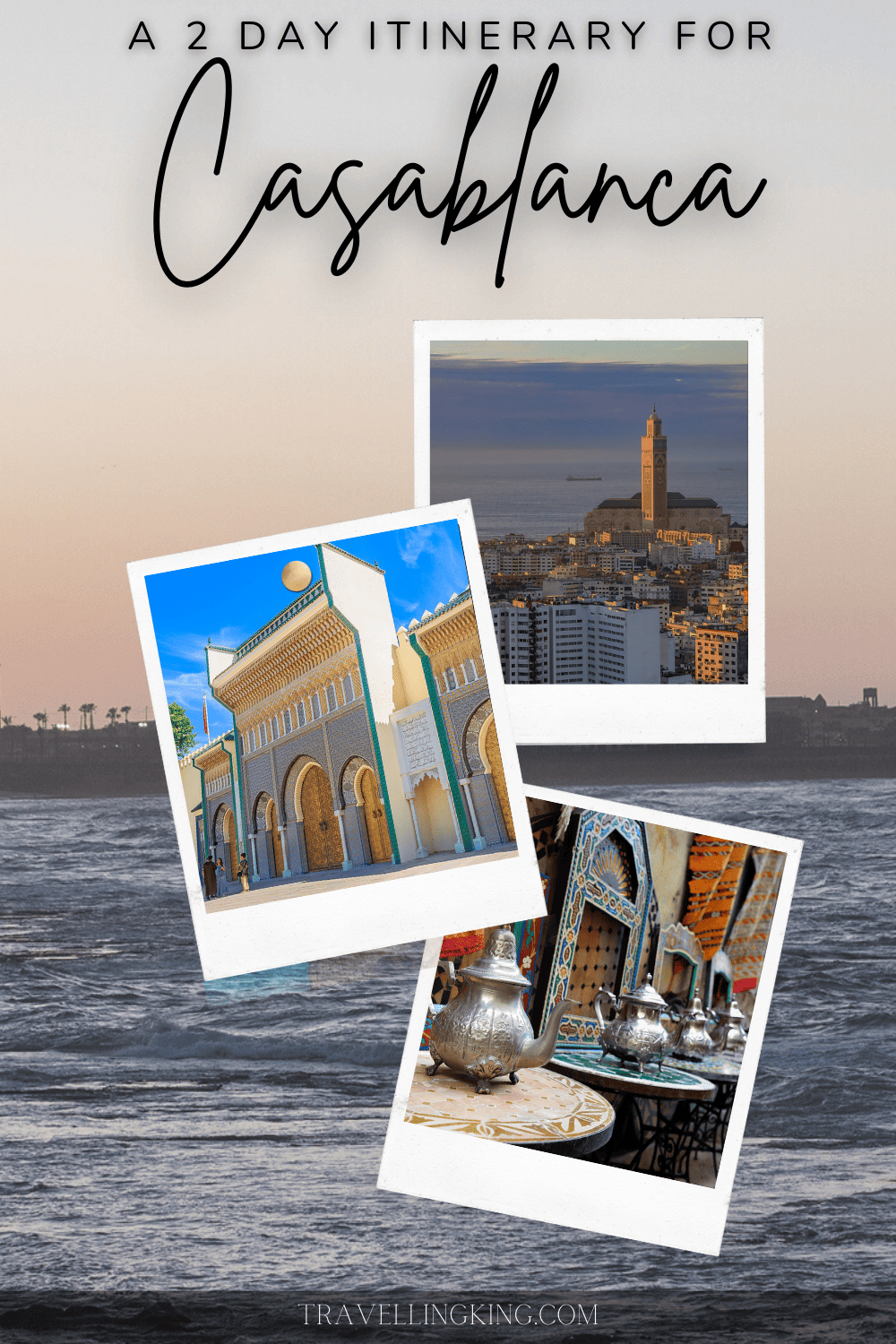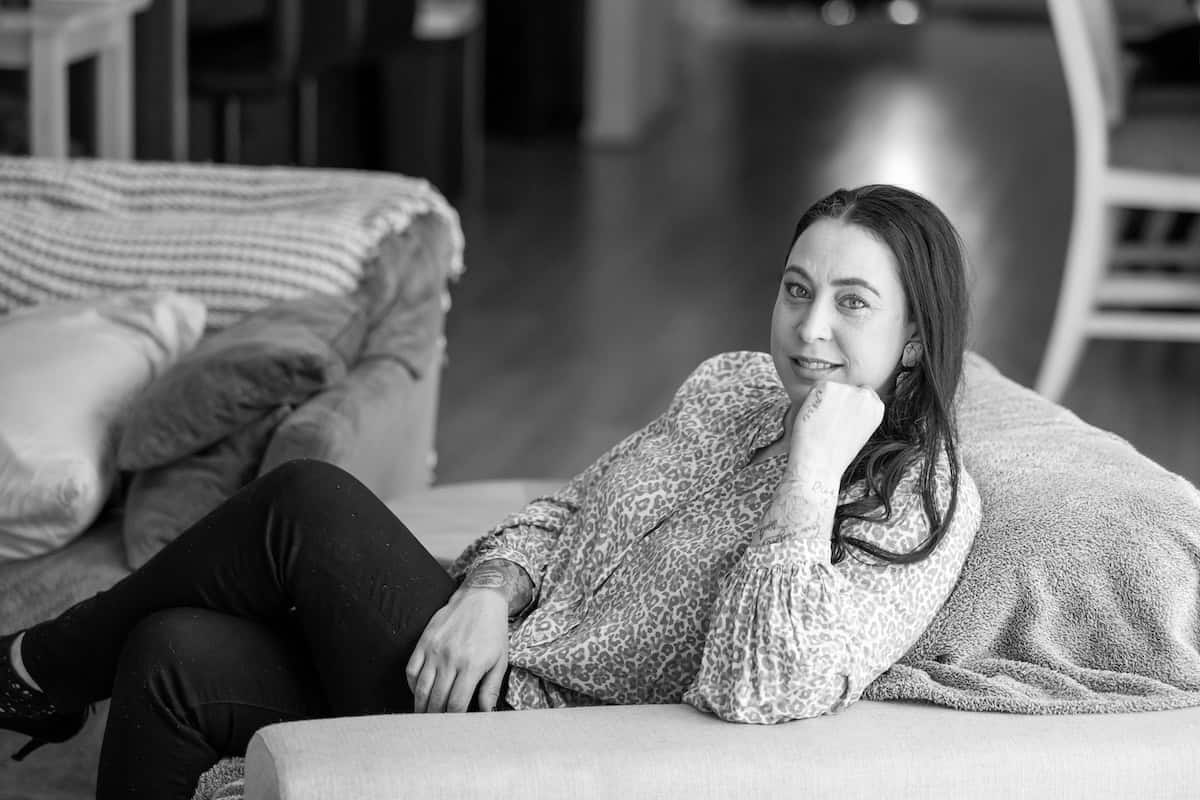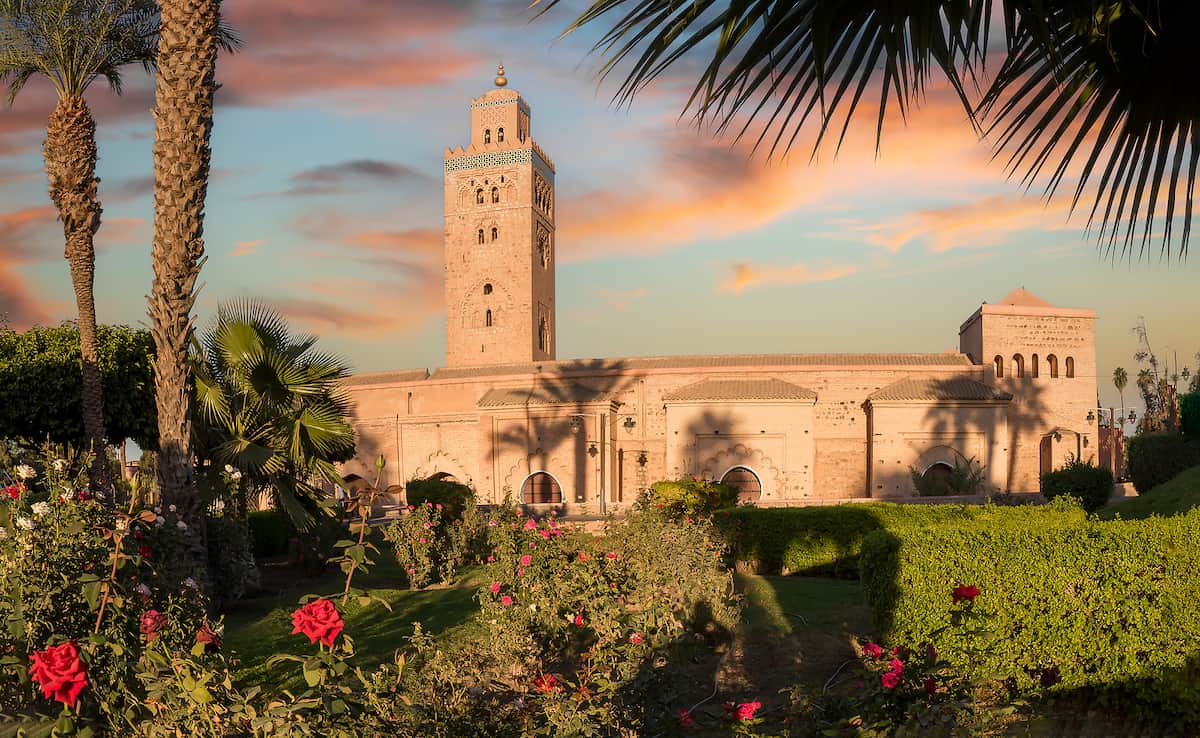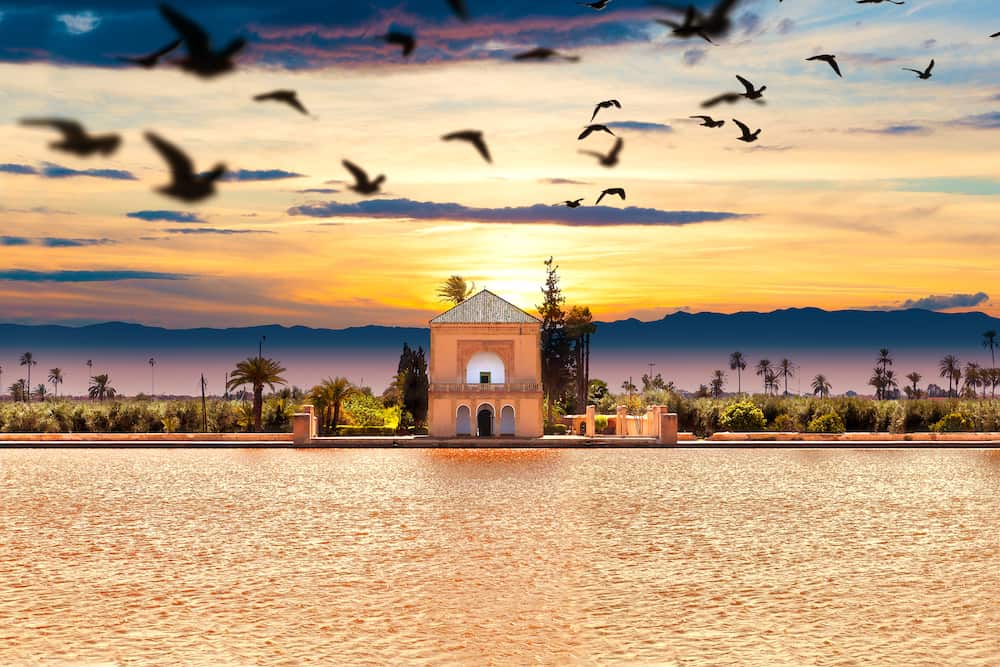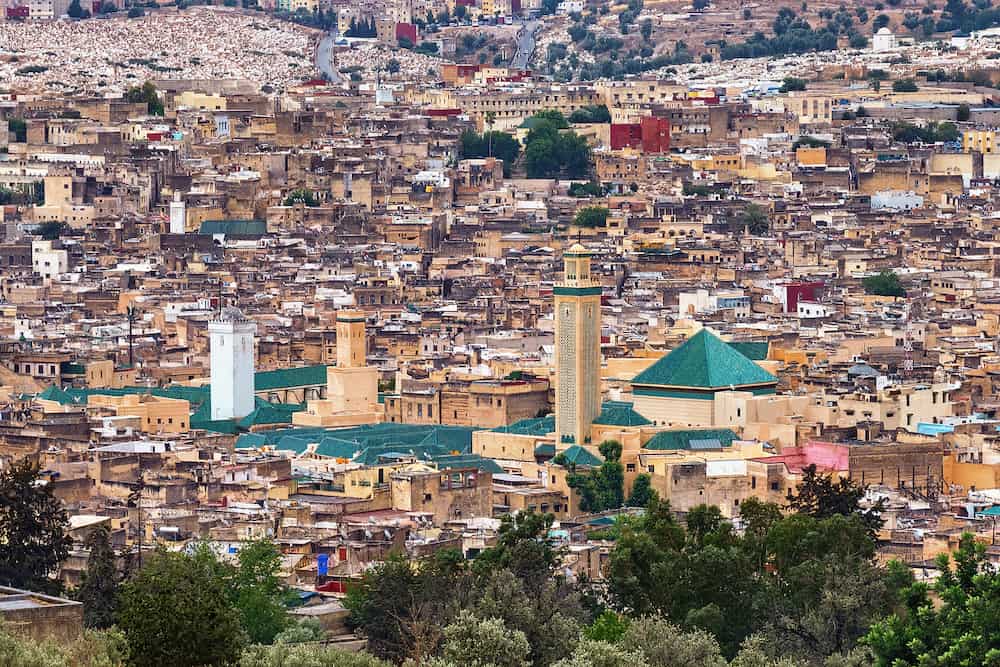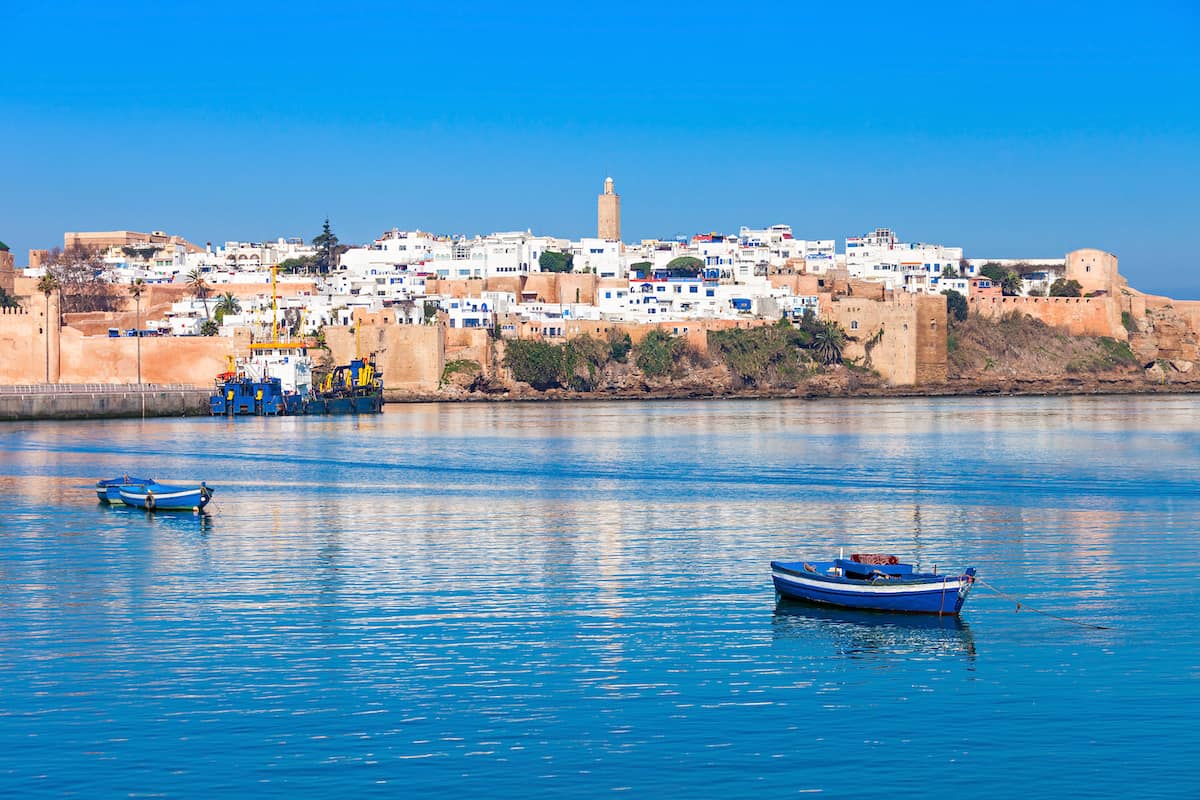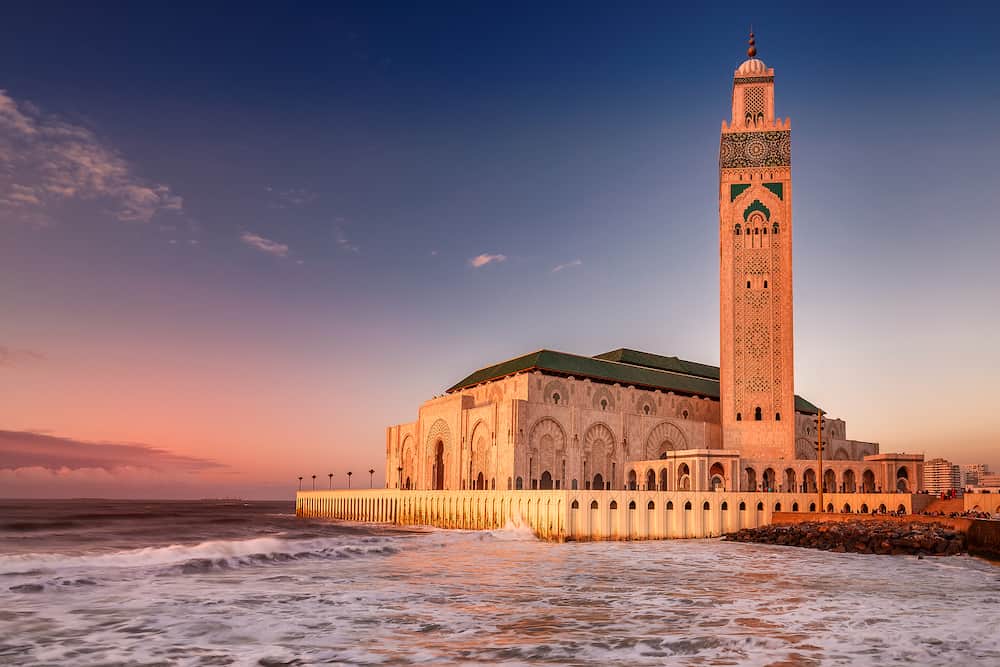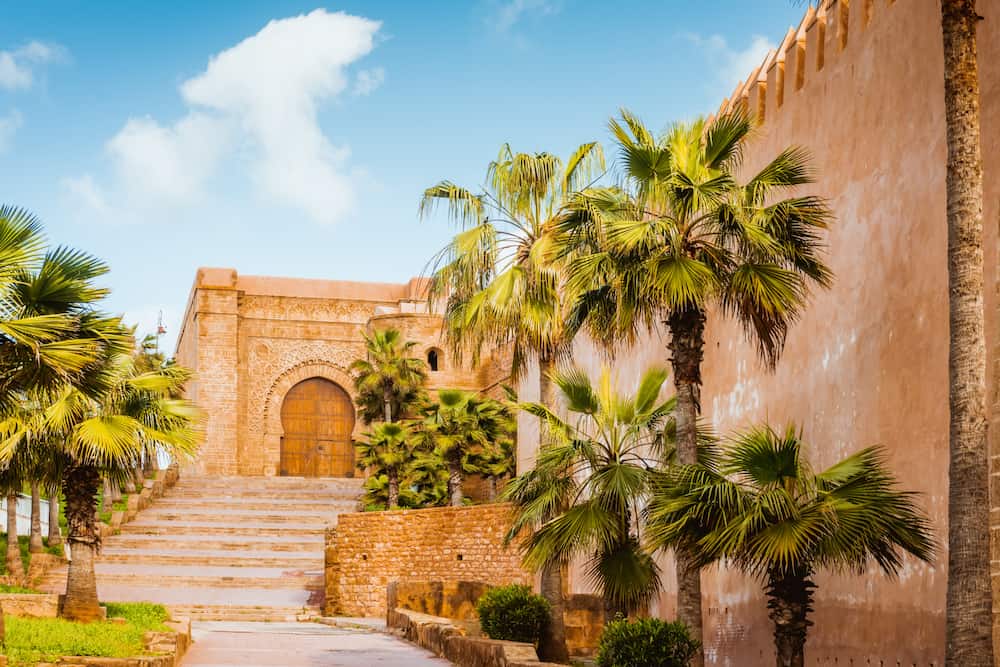48 hours in Casablanca – A 2 day Itinerary
A 2 day itinerary for Casablanca, Morocco would not be complete without a trip to Old Medina, the Royal palace, Quarter Habous, Hassan II Mosque, New Medina, the Jewish museum, Corniche and the Art Deco buildings.
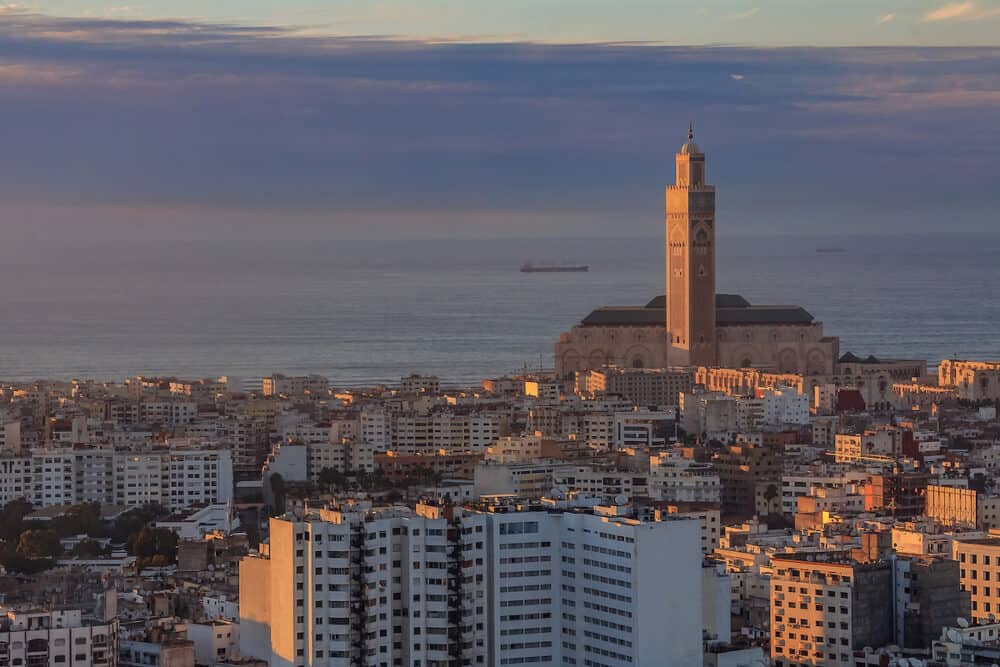
It sounds like a lot but this itinerary will leave you feeling satisfied with the time you spent in Morocco whilst also encouraging you to come back to Casablanca in the future.
With its Middle Eastern influence, ancient-ruin inspired cityscape and clear coastal waters, Casablanca is a city that beckons all.
Casablanca also draws on European influences making it a truly universal city to visit. Casablanca retains its old and traditional world charm whilst also ensuring that it caters towards the trendy, modern traveler.
In a hurry and need help quick?
Making last-minute plans for your Casablanca itinerary. We’ve got you covered. Our recommended hotels and tours for a getaway to Casablanca are listed below.
Recommended hotels:
- Premiere Classe Casablanca Centre Ville (budget hotel)
- Idou Anfa Hôtel & Spa (mid-range hotel)
- Mövenpick Hotel Casablanca (family hotel)
- Four Seasons Hotel Casablanca (luxury hotel)
Recommended tours:
- Casablanca City Tour with Hassan II mosque ticket
- Casablanca city tour, mosque fees included
- Morning Casablanca: The Medina and Beyond Cultural Walking Tour
- Casablanca City Night Tour and Traditional Moroccan Dinner
Other Helpful Links
- Cheap flights
- Savings on accommodation from hostels to luxury hotels
- Affordable car rental options
- Affordable sightseeing tours and day trips
- Travel Adapter – All in one so you don’t have to carry a bunch around
- Wise Card : hold up to 40+ currencies at once to spend in in over 150 countries
This post contains some affiliate links for your convenience. Click here to read my full disclosure policy.
Overview of 2 Day Itinerary for Casablanca
Day 1 in Casablanca:
- Old Medina
- The Royal Palace
- Jewish Museum
- Hassan II Mosque
Day 2 in Casablanca:
- New Medina
- Quarter Habous
- Art deco buildings
- Corniche
Day 1 in Casablanca
Old Medina
The Old Medina of Casablanca is a major quarter in the middle of the megacity that dates back to the 18th century. It’s a maze of narrow alleyways, bulging souks and traditional Moroccan splendor that offers a window into the city’s rich, artistic heritage.
Old Medina is a vibrant place where you can see crafters at work. They’re usually conversing with the locals, and refining their crafts. The souks are filled with stalls selling spices, fabrics, leather goods, crockery, and jewelry.
The merchandisers are always eager to haggle, so it’s a great place to test your skills and see if you can get a good bargain. Grab some breakfast as you walk the market because it’s going to be a busy day.
One of the most notable attractions of Old Medina is the Clock Tower, which is a popular meeting place for locals and tourists alike. The Clock Tower was erected in the early 20th century and is a cool culmination of the blend of Moroccan and European architectural styles that can be seen in Casablanca.
Another highlight of Old Medina is the Mahkama du Pacha, which is the former home of the Pasha of Casablanca. The palace is a stunning illustration of Moroccan architecture executed perfectly.
The palace boasts intricate pipe work, sculpted rustic ceilings, and beautiful auditoriums all adorned in gold which can be visited by tourists.
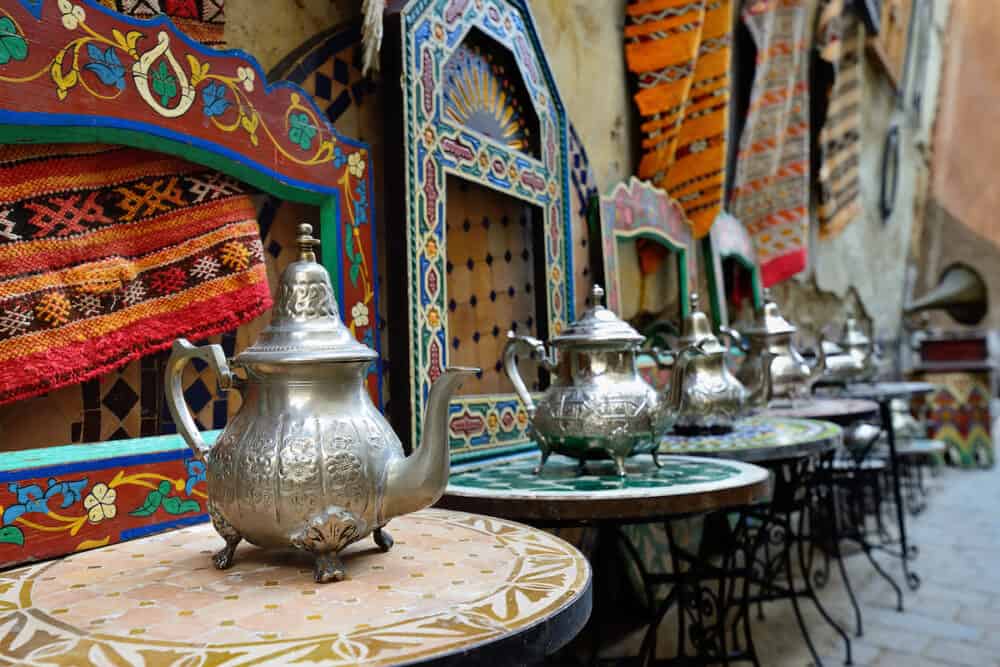
Royal Palace
Old Medina gently gave you a taste of traditional Morocco. Sticking with the ancient Moroccan theme, your next destination of the morning is the Royal Palace.
Located in the Anfa district, the palace is an imposing structure that covers an area of over 2 square kilometers and is surrounded by lush gardens and ornate gates. The Royal Palace was the residence of King Mohammed VI of Morocco.
As much as you’d like to take a peek behind the impressive walls and glimpse what the life of a sultan would have looked like, unfortunately the palace is not open to the public to peruse. However, you can still view its architectural structure from the outside.
The Royal Guard, whose men may be seen patrolling the grounds in their recognizable red and blue uniforms, is also housed within the castle.
Every day at noon, the guards perform a formal changing of the guard, which is a cool phenomena to see. Perhaps you could even compare it to the Royal Guard’s of London’s Buckingham Palace if you’ve seen it.
The Palace has a nearby park which tourists can walk through. Wear something white and flowy and think about how you would rule Morocco if you were the prince or princess of Casablanca living within the Royal Palace.
Don’t forget to check out the plaza on your way past the palace. Sometimes the plaza has a variety of events and ceremonies on show.
The horses and guards make their debut during these performances and strut their way through the colorful flags and flowers.
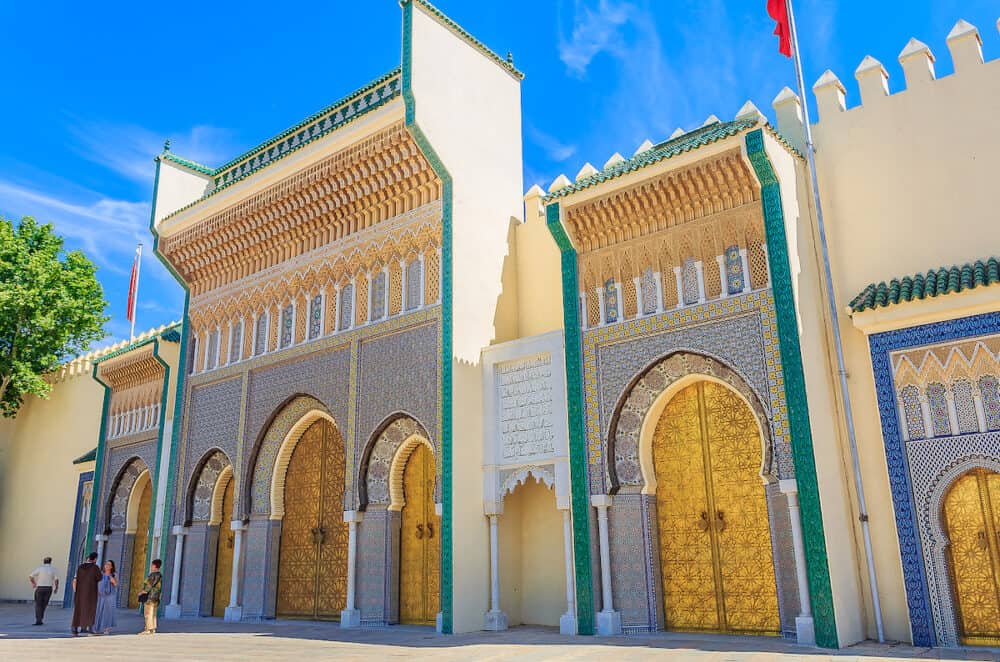
Jewish Museum
We’re sticking with everything traditional for today’s agenda and a traditional day in Casablanca wouldn’t be complete without a visit to the Jewish Museum.
The Jewish Museum of Casablanca is a cultural institution that celebrates the history and contributions of the Jewish community in Morocco and you’ll find it in the middle of the city.
Inside the museum, you’ll find a rich collection of artifacts, photographs, and documents that tell the story of Morocco’s Jewish community.
Visitors can see traditional clothing, ritual objects, and other items that reflect the cultural and religious traditions of Moroccan Jews. The exhibits also cover the history of Moroccan Jews and their contributions to the country’s art, music, and literature.
If you’re a book lover, this place will be heaven for you as the museum also has a collection of old Jewish books and manuscripts, which includes some of the oldest and most important texts in Jewish history.
These books are written in Hebrew, Arabic, and Judeo-Arabic, and many of them are written with intricate calligraphy and small illustrations.
Hassan II Mosque
Tick off two Casablancan greats at your next location which is the Hassan II Mosque. The mosque is accompanied by the Atlantic ocean, meaning that you’ll also get to experience a bit of the Moroccan coastline today.
We’re also just in time for sunset! Expect to see a grand phenomenon as the last golden rays bounce off the mosque’s shell and across the Atlantic ocean like a pool of honey.
The Hassan II Mosque is considered one of the largest mosques in the world. The mosque was built to commemorate the late King Hassan II, who wanted to create a religious and cultural center that would reflect the traditional values of Morocco.
The mosque’s features have certainly done that with azure-colored mosaics, carved wood, and marble columns, which were handcrafted by skilled Moroccan artisans. The mosque’s minaret is the tallest in the world, reaching a height of 210 meters (689 feet), and can be seen from miles away.
Even if you don’t partake in worship, you should consider looking at one of the mosque’s most impressive features – The prayer hall.
It can accommodate up to 25,000 worshippers at a time. The hall is adorned with chandeliers that are handcrafted from Moroccan brass and glass and are lit up with thousands of light bulbs, creating a breathtaking atmosphere.
You can take a guided walk inside and then emerge to watch the sun set over the mosque’s courtyard and terrace.
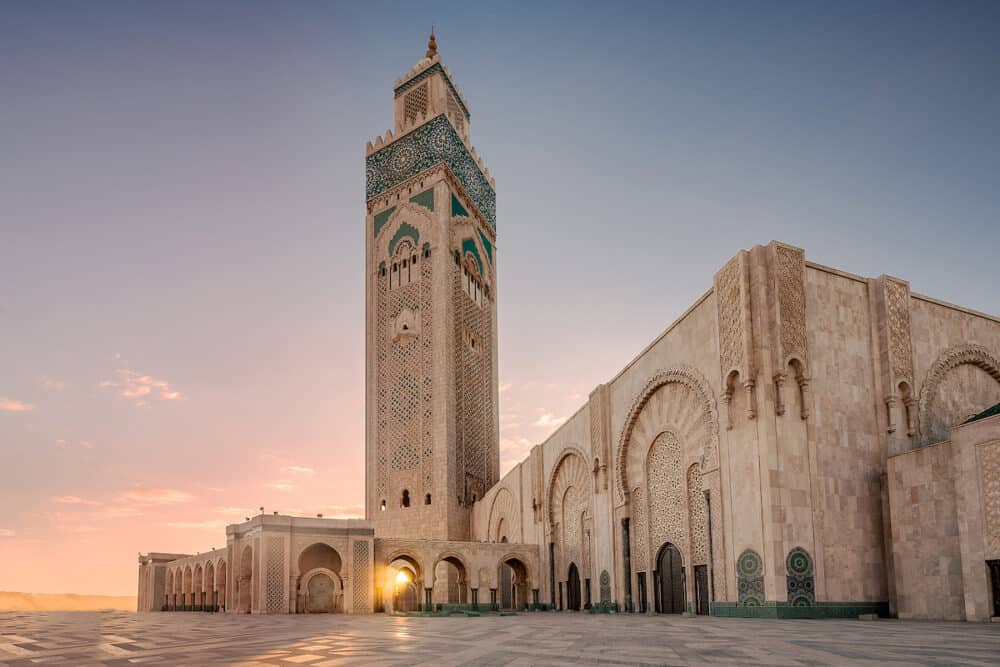
Day 2 in Casablanca
New Medina
Yesterday we explored the old while today we’re exploring the new. Today you’ll see the global influence the world has had on Casablanca and how the city has adapted to the role of tourism whilst still retaining authenticity.
We’re starting the morning off by people watching and taking in the town with a coffee in hand at Cafe Central. Cafe Central is a popular coffee shop located in the heart of New Medina. It is known for its traditional Moroccan coffee and pastries, as well as its cozy atmosphere.
Now that you’re caffeinated, you can explore the variety of shops that New Medina has to offer where visitors can learn about traditional Moroccan crafts, such as ceramics, leatherwork, and woodworking. You can watch local artisans at work and even try your own hand at creating a unique Moroccan craft.
Take notice of your surroundings as you’re bound to come across a vibrant street covered in street art. Many of the buildings are decorated with colorful murals and graffiti. Take a stroll through the neighborhood and see if you can spot some of the most interesting artworks.
In the same vicinity, you’ll find a large square located in the heart of the New Medina, surrounded by cafes and restaurants called the Place des Nations Unies. The square was named after the United Nations, and you’ll find a beautiful fountain in the center.
Next up is exploring the Spanish-Moorish Garden which is a grand park located within central New Medina. It features a combination of Spanish and Moroccan design elements, with fountains, mosaics, and colorful tile work. You can take a leisurely stroll through the gardens and enjoy the peaceful surroundings.
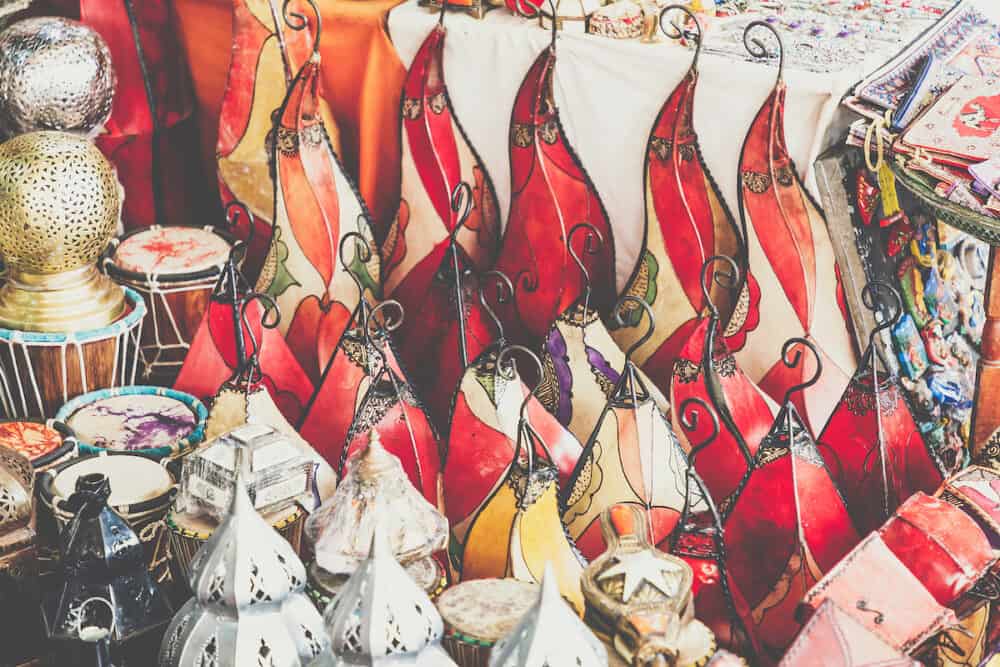
Quarter Habous
Coming up next on the agenda is the Quarter Habous, located in New Medina. Since you’ve just explored New Medina, you may have heard that the Quarter Habous is highly recommended by both locals and tourists who have already explored the area.
The Quarter Habous is known for its wide boulevards, arcades, and white buildings with red-tiled roofs, which creates a cross between European and Moroccan architecture.
It was built in the 1920s during the French Protectorate era, and it was designed to be a new, modern medina that would reflect the cultural heritage of Morocco. Are you starting to see the modern development of Casablanca yet?
Things to do in the Quarter Habous
We’ve seen the Royal palace but it’s not the only thing to do in the Quarter Habous (even though the palace takes up a lot of the quarter). The central market is where we’ll be stopping for lunch and what a lunch it will be.
You’ll be spoilt for choice with various foods on offer such as spicy lamb kabobs, tangy mint dressings, freshly baked breads, sweet treats, salted vegetables and fried delicacies. Drooling yet?
The central market also sells textiles, jewelry, and souvenirs which are scattered amongst many restaurants and cafes where you can sample traditional Moroccan cuisine and enjoy the lively atmosphere.
Close to the central market and within the Quarter Habous is the Ettedgui Synagogue, which was built in the 1930s and features beautiful Moroccan-Jewish architecture, with colorful tile work and stained glass windows.
Inside the synagogue, visitors can see the beautiful Torah ark, which is made of carved wood and decorated with colorful mosaics. The walls are adorned with photos and paintings that depict the history of the Jewish community in Casablanca.
The Synagogue is a true cultural experience that is wonderful to see regardless of your religion and beliefs.
Another main attraction of the Quarter Habous is the Mohammed V Square. It is a large, open space that is surrounded by bold buildings and pretty palm trees. The square was named after the former king of Morocco. If you want that iconic, instagrammable location to take photos, this is where you’ll go.
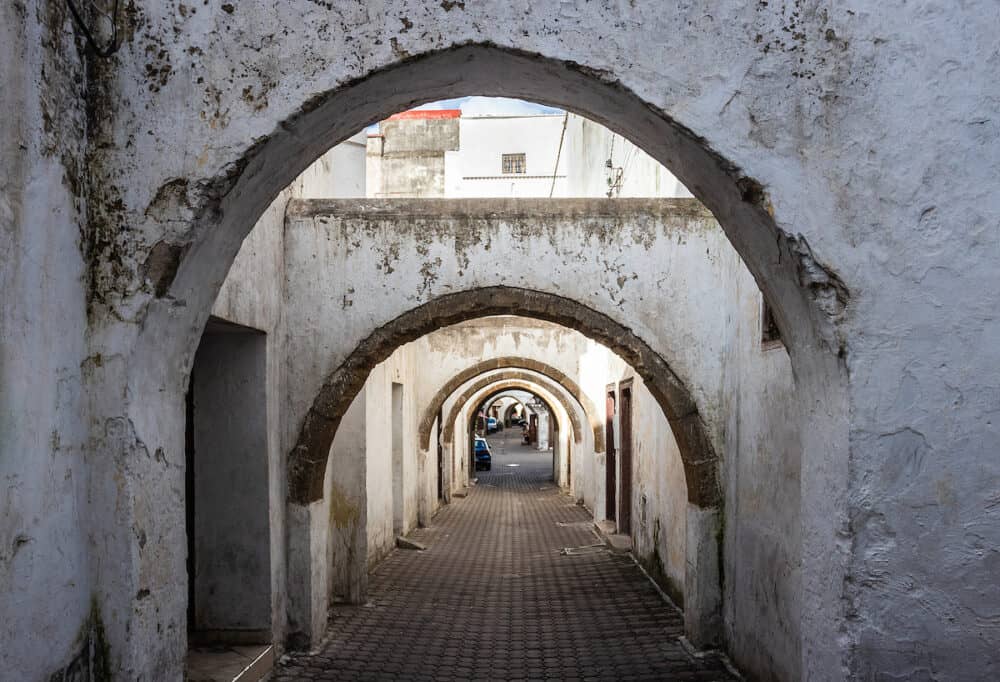
Art Deco Buildings
Today is all about seeing the transition of old Casablanca to new Casablanca and there couldn’t be anything more fitting than a visit to the Art Deco Buildings.
Casablanca is known for its collection of Art Deco buildings, which were built during the 1920s and 1930s when the city was experiencing a period of rapid growth and modernization.
All of the buildings have a signature style which draws on geometric shapes, bold colors, and decorative elements from around the globe and Morocco.
They also characteristically feature flat roofs, rounded corners, and intricate decorative motifs, such as ziggurats, zigzag patterns, and stylized plant and animal motifs.
Where to find them?
Many of the Art Deco buildings in Casablanca are located in the downtown area, including the Boulevard Mohammed V, the Place des Nations Unies, and the Avenue Hassan II. Some of the most notable Art Deco buildings in Casablanca include the Cinema Rialto, the Hotel Transatlantique, and the Villa des Arts.
If you don’t feel like gallivanting everywhere to find them (although that would make a cool “amazing race” themed afternoon) you could always go on a guided tour.
Over the years, many of Casablanca’s Art Deco buildings fell apart or were demolished to make way for new developments.
However, in recent years, there has been a renewed interest in preserving the city’s Art Deco heritage. Due to this, several buildings have been restored and converted into museums, galleries, and other cultural spaces.
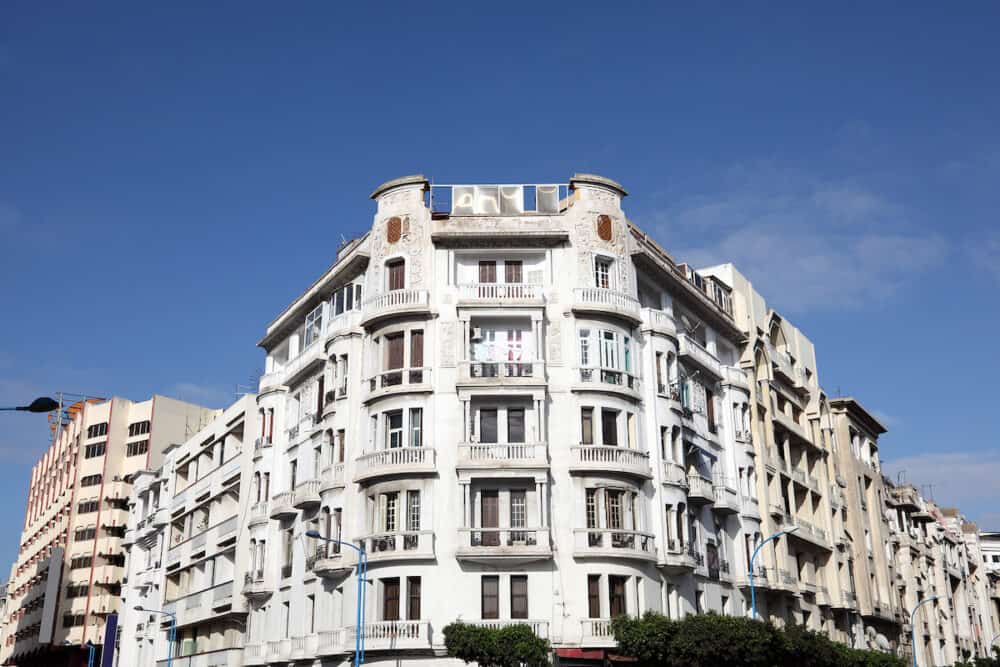
Corniche
We’re switching the streets for the sea next. The Corniche of Casablanca is a long coastal boulevard that stretches for several kilometers along the Atlantic Ocean. It is a popular tourist destination in the city due to its views and exciting entertainment.
Start off by strolling along the promenade, which is lined with palm trees, cafes, and restaurants which offer the best ocean views in the whole of Casablanca.
Then spend the afternoon relaxing on the beach, which is a welcome break after the hustle and bustle of this morning’s market adventures. Choose from several beaches, such as Ain Diab Beach and La Corniche Beach. All of which offer a range of water sports, such as jet skiing and parasailing.
As the sun sets, choose from some of the most decadent local restaurants for dinner and then enjoy the several nightclubs and bars that come alive at night. Depending on your preference, you can enjoy the live music, dance the night away, or simply relax with a cocktail and enjoy the ocean views.
Another unique way to end your final evening in Casablanca is at a film screening at Cinema Rialto which is a historic movie theater in New Medina.
It was built in the 1930s and pays tribute to the Art Deco District we saw earlier today. You can attend a film screening, relax and experience the unique atmosphere of this historic cinema.
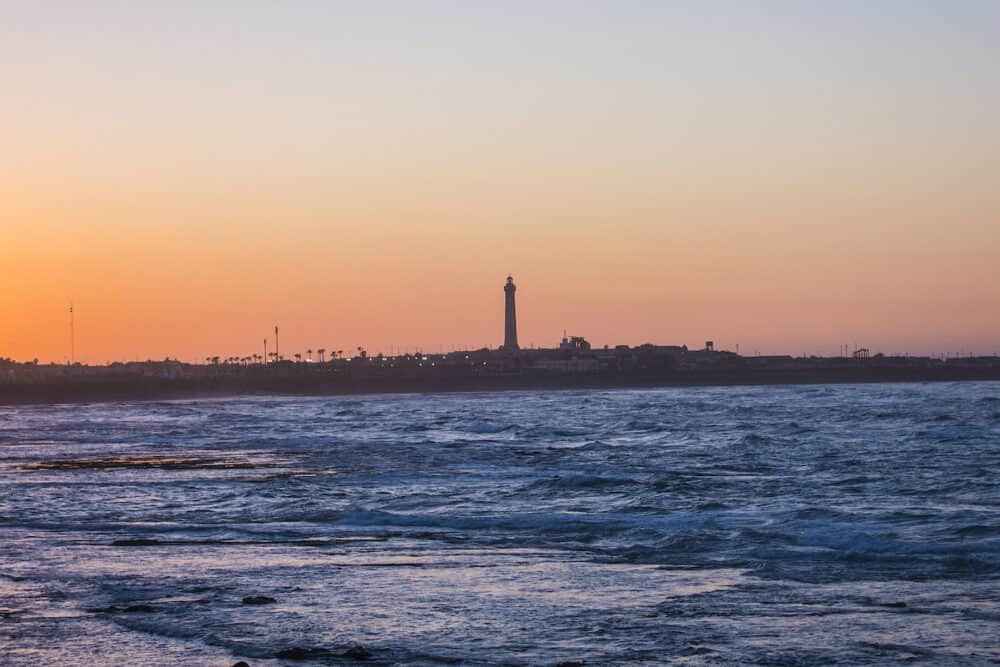
After 48 hours in Casablanca, did you feel as though you’d been transported into the 1942 film Casablanca?
Your trip has been quite the success. You’ve explored traditional Casablanca and modern Casablanca, learned how different each side is and experienced the native culture, tradition and cuisine of each.
Similar to a mottled blue and beige painting, Casablanca is a city that is striking from above (which can be admired as you fly in) and even more intricate from below. Which side was your favorite? Old or new Casablanca?
Recommended tours in Casablanca
- Casablanca City Tour
- Morning Casablanca: The Medina and Beyond Cultural Walking Tour
- 10D 9N Private Morocco Tour From Casablanca By Imperial Cities And South Desert
- Best Tour Of Morocco in 5-Day Culture and Desert Tour
- Casablanca Day Tour
- Highlights of Morocco; Imperial cities and Sahara desert
- Discovering Life & Walk Inside Old Medina
- Casablanca Food Tour – Moroccan Street Food Tour
If you’d like to save it for later, please save it to Pinterest.
